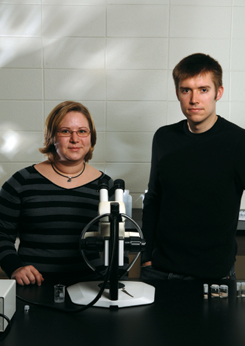Eye on the Quads
Ocean's informants
Oceanic fossils shed light on climate change.
When you talk to Shannon Loomis and Thomas Bauska about the work they are doing in their fourth-floor lab at Henry Hinds Laboratory you are reminded of the odd timescale in which geologists work. To most people, a fossil record spanning 2,000 years would seem to cover a long period of time, but Loomis, who is examining data from such a span, refers to them as “minute slices.” Similarly, Bauska calls the data they are looking at “comparatively recent”: they are 400,000 to 800,000 years old.
You are also reminded that science takes minutiae and uses it to understand the big picture. The two fourth-year geophysical sciences majors are examining the remains of foraminifera, single-cell creatures that have populated the earth’s oceans for almost 600 million years and are still one of the most abundant marine life forms. What they are looking at is how the forams (for short) act as recorders of the planet’s climate. What the fossil forams Loomis and Bauska are studying reveal about climate change in the Pleistocene epoch might in turn shed light on climate change in our own time.
“I look at the different numbers of whole foram shells versus the number that are fractured, which reveals the levels of carbon dioxide in the atmosphere when they were living,” says Loomis. Bauska’s work involves comparing the ratio of magnesium to calcium in the forams’ shells, which is an indicator of the temperature of the ocean when the creatures were alive, providing a picture of the temperature of the earth.
The students’ work is part of a larger project funded by the National Science Foundation that is using data provided by the forams’ temperature record to help scientists understand climate change and global warming in the present day by examining a time when the earth’s climate went through a radical change—the Mid-Pleistocene Revolution, which began about 850,000 years ago and saw the cycle between the creation and retreat of glaciers lengthen while swings in average temperature became less severe.
Pointing to a chart that looks like the cardiogram of someone whose heartbeat is slowing down, Bauska says, “We went from smaller swings that happened in 40,000- or 50,000-year cycles to big swings in glaciation, where they were occurring in 100,000-year cycles. We’re trying to figure out why that happened, and that can tell us about our climate.” Loomis and Bauska’s faculty advisor, Assistant Professor of Geophysical Sciences Pamela Martin, points out that their work has serious implications. “The mantra is that understanding the past is the key to understanding the future of climate change,” she says. “What Shannon and Thomas are examining is very much related to climate change today because we are changing the climate by increasing atmospheric CO2 and we can look at the past to see how changes in carbon dioxide affected the climate then.” For example, Loomis’s research is showing how much carbon dioxide the oceans were able to hold, which helps in understanding increases in temperature today, when oceanic CO2 levels are at a peak. Bauska’s research examines changes in the ocean’s temperature, providing vital data for scientists studying the effect of CO2 concentrations in the atmosphere.
Both Loomis and Bauska arrived at their research almost by accident. Both came to the University of Chicago expecting to be physics majors but each detoured to this different precinct of the physical sciences after discovering that the realities of physics didn’t gibe with their interests—after a working as a forest firefighter in Oregon last summer Bauska discovered that he preferred fieldwork to the confines of a lab, and Loomis found physics too theoretical and wanted the chance to do more reality-based research. They made the leap to forams as a result of a job posting. “There was an ad for worker bees for the lab because there’s the need to count the forams, to do the cleanup, and to do the chemistry,” says Bauska. From there they have moved to much higher levels of foram research due in part to their diligence, but mostly as a result of their insight and understanding, according to Martin.
Besides being part of the NSF climate change project, Loomis and Bauska’s research in Martin’s lab provided them with the topics of their senior BA projects. It is also likely to be the foundation of still more projects; both plan to pursue careers in the sciences. Bauska intends to enroll in a doctoral program where he hopes to study tiny bubbles trapped in arctic ice—effectively, small samples of air that is thousands of years old—in order to chart a different and a more detailed history of the earth’s climate.
Loomis foresees more school in her future as well, but is not as certain about what she will study. Lately her interest has gravitated towards paleobotany, the study of ancient plants, because she enjoyed the fieldwork she performed under the auspices of the Smithsonian, looking for fossil plants in the Bighorn Basin in Wyoming.
Regardless of where the road from Hinds Lab leads them, Bauska and Loomis appreciate the chance they’ve had to make a tangible contribution to some of the most pressing questions facing scientists today. “These records tell us a lot about climate qualities during the Pleistocene Revolution and that can be compared to current climate changes,” says Bauska. As the debate over global warming continues, understanding climate change is becoming more important than ever. By uncovering the secrets of the past, scientists like Loomis and Bauska could be providing clues about our future.—Mark Johnson, AB’83
